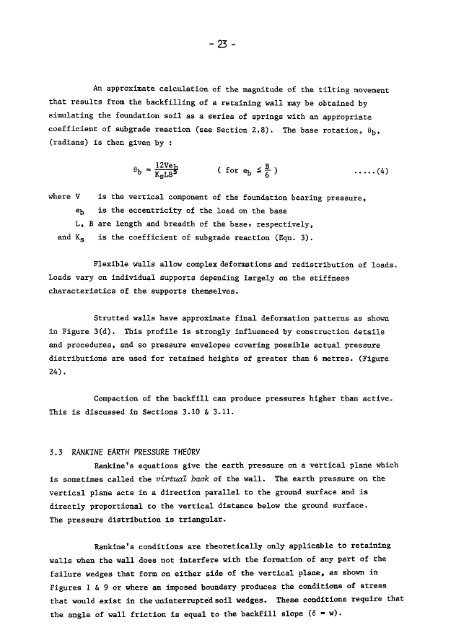4 - HKU Libraries
4 - HKU Libraries
4 - HKU Libraries
Create successful ePaper yourself
Turn your PDF publications into a flip-book with our unique Google optimized e-Paper software.
-23 -An approximate calculation of the magnitude of the tilting movementthat results from the backfilling of a retaining wall may be obtained bysimulating the foundation soil as a series of springs with an appropriatecoefficient of subgrade reaction (see Section 2.8). The base rotation, 6 b ,(radians) is then given by :T>( for e b $ 7- ) . (4)where V is the vertical component of the foundation bearing pressurese^ is the eccentricity of the load on the baseL, B are length and breadth of the bases respectively,and K s is the coefficient of subgrade reaction (Eqn. 3).Flexible walls allow complex deformations and redistribution of loads,Loads vary on individual supports depending largely on the stiffnesscharacteristics of the supports themselves.Strutted walls have approximate final deformation patterns as shownin Figure 3(d). This profile is strongly influenced by construction detailsand procedures, and so pressure envelopes covering possible actual pressuredistributions are used for retained heights of greater than 6 metres* (Figure24).Compaction of the backfill can produce pressures higher than active.This is discussed in Sections 3.10 & 3.11.3.3 RANKINE EARTH PRESSURE THEORYRankine's equations give the earth pressure on a vertical plane whichis sometimes called the victual back of the wall. The earth pressure on thevertical plane acts in a direction parallel to the ground surface and isdirectly proportional to the vertical distance below the ground surface.The pressure distribution is triangular.Rankine f s conditions are theoretically only applicable to retainingwalls when the wall does not interfere with the formation of any part of thefailure wedges that form on either side of the vertical plane, as shown inFigures 1 & 9 or where an imposed boundary produces the conditions of stressthat would exist in the uninterrupted soil wedges. These conditions require thatthe angle of wall friction is equal to the backfill slope (6 » w).

















